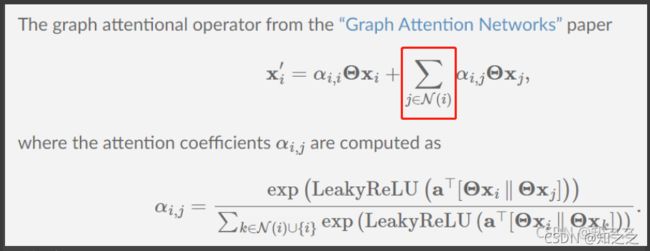cs224w-图机器学习-Colab 3
这里写自定义目录标题
- 一、GCN
- 二、GAT
-
- 1.forward函数
- 2.message函数
- 3.aggregate函数
- 4.总结
一、GCN
二、GAT
1.forward函数
下面是库中的实现。
def forward(self, x: Union[Tensor, OptPairTensor], edge_index: Adj,
size: Size = None, return_attention_weights=None):
# type: (Union[Tensor, OptPairTensor], Tensor, Size, NoneType) -> Tensor # noqa
# type: (Union[Tensor, OptPairTensor], SparseTensor, Size, NoneType) -> Tensor # noqa
# type: (Union[Tensor, OptPairTensor], Tensor, Size, bool) -> Tuple[Tensor, Tuple[Tensor, Tensor]] # noqa
# type: (Union[Tensor, OptPairTensor], SparseTensor, Size, bool) -> Tuple[Tensor, SparseTensor] # noqa
r"""
Args:
return_attention_weights (bool, optional): If set to :obj:`True`,
will additionally return the tuple
:obj:`(edge_index, attention_weights)`, holding the computed
attention weights for each edge. (default: :obj:`None`)
"""
#分别对应head数(即有几套注意力系数)和下层特征维度
H, C = self.heads, self.out_channels
x_l: OptTensor = None
x_r: OptTensor = None
alpha_l: OptTensor = None
alpha_r: OptTensor = None
if isinstance(x, Tensor):
assert x.dim() == 2, 'Static graphs not supported in `GATConv`.'
#这是把本层特征变换到输出空间中。
x_l = x_r = self.lin_l(x).view(-1, H, C)
#这是准备计算$e_{i,j}$,把两个向量算好
alpha_l = (x_l * self.att_l).sum(dim=-1)
alpha_r = (x_r * self.att_r).sum(dim=-1)
else:
x_l, x_r = x[0], x[1]
assert x[0].dim() == 2, 'Static graphs not supported in `GATConv`.'
x_l = self.lin_l(x_l).view(-1, H, C)
alpha_l = (x_l * self.att_l).sum(dim=-1)
if x_r is not None:
x_r = self.lin_r(x_r).view(-1, H, C)
alpha_r = (x_r * self.att_r).sum(dim=-1)
assert x_l is not None
assert alpha_l is not None
if self.add_self_loops:
if isinstance(edge_index, Tensor):
num_nodes = x_l.size(0)
if x_r is not None:
num_nodes = min(num_nodes, x_r.size(0))
if size is not None:
num_nodes = min(size[0], size[1])
edge_index, _ = remove_self_loops(edge_index)
edge_index, _ = add_self_loops(edge_index, num_nodes=num_nodes)
elif isinstance(edge_index, SparseTensor):
edge_index = set_diag(edge_index)
# propagate_type: (x: OptPairTensor, alpha: OptPairTensor)
#这个函数很神奇。传进去的alpha=(alpha_l, alpha_r)这俩参数,到了message函数中,就自动变成
#205*head维度的了。其中205是边数,head是注意力个数。
#而且,这俩参数自动加上后缀_i和_j,就在message函数中,就自动变成alpha_i和alpha_j了
out = self.propagate(edge_index, x=(x_l, x_r),
alpha=(alpha_l, alpha_r), size=size)
alpha = self._alpha
self._alpha = None
if self.concat:
out = out.view(-1, self.heads * self.out_channels)
else:
out = out.mean(dim=1)
if self.bias is not None:
out += self.bias
if isinstance(return_attention_weights, bool):
assert alpha is not None
if isinstance(edge_index, Tensor):
return out, (edge_index, alpha)
elif isinstance(edge_index, SparseTensor):
return out, edge_index.set_value(alpha, layout='coo')
else:
return out
2.message函数
def message(self, x_j: Tensor, alpha_j: Tensor, alpha_i: OptTensor,
index: Tensor, ptr: OptTensor,
size_i: Optional[int]) -> Tensor:
# alpha_j 和 alpha_i都是从propagate函数传来的。分别对应着每个边头结点的alpha和尾结点的alpha
#这样,相加后,205个数据分别对应着每个边的注意力系数
alpha = alpha_j if alpha_i is None else alpha_j + alpha_i
alpha = F.leaky_relu(alpha, self.negative_slope)
alpha = softmax(alpha, index, ptr, size_i)
self._alpha = alpha
alpha = F.dropout(alpha, p=self.dropout, training=self.training)
#返回乘以注意力系数后的表示
return x_j * alpha.unsqueeze(-1)
3.aggregate函数
这个函数的作用很单一:接收边序列和边序列对应的节点表示,然后求和。所以在调用这个函数之前,所有参数都应该算好了。因此message函数的负担很大。
4.总结
公式中,除了求和操作是aggregate函数实现的,其他操作都是在forward和message中实现的。因此具体在哪实现应该不太重要。仿照别人写的写就行了。一般都是在forward中进行线性投影,准备好一些向量。其他涉及中心节点、边序列的操作,只能在message中完成。因为调用message之前,propagate函数早就做好了准备,把_i和_j数据准备好了。

GAT实现中,在forward中实现下面的红色部分:

在message中实现了如下红色部分:

在aggregate中实现了如下:
上面几个截图都忽略了自环的部分。
